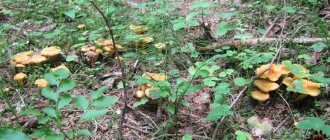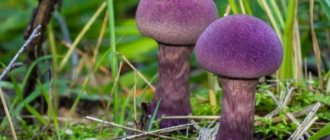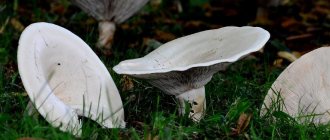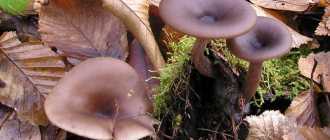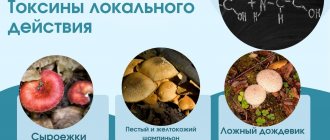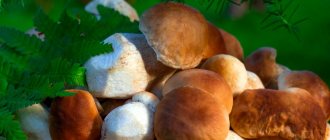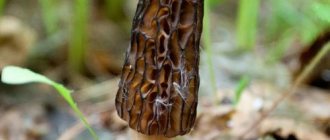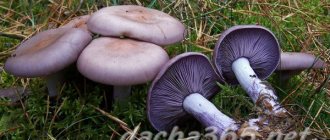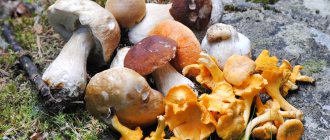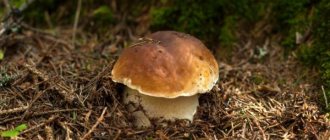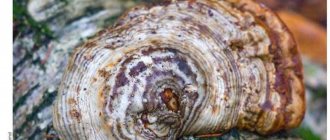Mushrooms germinate throughout the Russian Federation from the beginning of spring until the first frost. And in some regions where the temperature does not fall below 0 degrees, winter mushrooms delight mushroom pickers even in the cold months. December, January and February, although not the most popular mushroom months, are still relevant among professionals who know all the breeds not only by description and pictures, but also visually. But what should beginners do who don’t know most of the popular mushrooms, but want to make quiet hunting their hobby? As an option, find out the names of mushrooms with pictures, finding out which mushrooms are edible and which are inedible based on the description with the photo.
Today’s article contains the most popular types of mushrooms with detailed descriptions and distinctive features that tell how to distinguish false and poisonous species from conditionally edible and edible mushrooms. Useful information, presented briefly, can become not only useful in studying, but also a lifesaver and an extra reminder during a quiet hunt.
What are edible mushrooms
Edible mushrooms are a type that can be used raw, dried or boiled without any special pre-treatment. They do not contain toxic or harmful substances that can harm human health.
While science has not identified a specific classification of mushrooms, they can be divided according to nutritional characteristics into edible, conditionally edible and poisonous.
Classification of mushrooms Conditionally edible are species that are prohibited for use in raw form, without heat treatment. As a rule, they contain only a small number of toxic substances. There are many subtleties of using such mushrooms for food: some can be eaten exclusively at a young age, others should be prepared in a certain way, and others should not be consumed with certain types of products, say, with alcoholic beverages. These are often soaked, boiled, doused with boiling water, salted or dried.
Edible and conditionally edible mushrooms, in turn, are divided according to their structure into:
- tubular;
- lamellar;
- marsupials
Types of mushrooms by cap structure
Useful properties of mushrooms
Regardless of the type of mushroom, we can generalize that all edible and conditionally edible varieties consist of 85-90% water. The rest is proteins, fats, carbohydrates, fiber and minerals. Almost all mushrooms are low-calorie. Only three varieties of mushrooms can be considered an exception to the rule, and then only in dried form. We are talking about boletus, aspen and porcini mushrooms.
1) Mushrooms are ideal for the diet for gastrointestinal diseases, diabetes and kidney diseases.
2) Fresh mushrooms are low-calorie and suitable for dietary nutrition.
3) The fats contained in mushrooms can replace meat dishes.
4) A rich number of vitamins, amino acids and microelements allow you to saturate the body with everything you need.
5) Some breeds are used for folk treatment of many diseases.
Structure and main characteristics of edible mushrooms
Mushrooms are defined as amazing representatives of the kingdom of nature, because they combine qualities inherent in both animals and plants. All, excluding morels, strings and truffles, contain a cap and a stem - the fruiting body. The thinnest threads located underground are mycelium.
Mushrooms, like plants, have a cellular shell, they feed by obtaining nutrients from the soil, and reproduce with the help of spores. In addition, they are inactive. A similar feature with animals is the presence of multicellular forms and chitin, which is characteristic only of the skeletons of arthropods.
Mushroom structure
There are signs by which an edible mushroom is identified. However, they are quite general, so you don’t need to rely entirely on them:
- the mushroom should not have a sharp, pungent odor or too garish a color;
- does not change color when the cap is cut or broken, but it is often noted that the flesh darkens when cooked;
- often has a tubular layer under the cap, a kind of “skirt” on the stem, the plates are very tightly attached to it.
These species are very fond of various insects that can be found on their surface.
Signs of edible mushrooms
Differences
Sometimes poisoning occurs due to one piece of toadstool or red fly agaric that gets on the table along with edible mushrooms. In order not to confuse edible and inedible mushrooms, it is necessary to accurately understand which specimens are common in the area and what they look like. Only the mushroom that is well known is placed in the basket.
Some varieties of edible and inedible crops are similar to each other. Despite the similarities, they also have a number of differences.
- Appearance: the color of edible specimens is often dull, but there are exceptions. For example, the chicken mushroom has a bright yellow cap. The poison in inedible organisms repels insects. Edible specimens most often contain a lot of worms and beetles. Edible varieties also have a skirt. Most poisonous ones do not have it.
- Discoloration at the break (cut): edible and poisonous mushrooms are characterized by this feature. In edible specimens it becomes beige or brown, while in poisonous specimens it acquires a brighter color (red, orange), or the dangerous mushroom turns blue.
- Smell: This is often what determines edibility. Almost all edible mushrooms have a pleasant aroma. Parasitic mushrooms and specimens not suitable for food have a chlorine or medicinal odor, but there are exceptions (fly agaric).
- Cap surface: Many inedible varieties have a sticky cap that feels sticky to the touch. It is also worth avoiding those specimens that do not have a tubular layer under the cap.
- Base of the leg: in poisonous specimens, the base of the leg is almost always immersed (surrounded) by a special sac (volva) - a remnant of the common veil. Edible mushrooms do not have such a formation. Also, in inedible and poisonous specimens, in addition to the volva, the base of the stalk is expanded into a tuber-like well-defined formation.
These are the main differences between edible and inedible mushrooms. Of the poisonous species in Russia, the most common are the pale toadstool (green fly agaric), red fly agaric, thin pig and satanic mushroom. The pale grebe is deadly.
If the above signs are absent, but you are not sure that the specimen found does not contain toxic substances, you should not take it.
How to distinguish an edible mushroom from an inedible one
Experienced mushroom pickers recommend that when picking mushrooms, pay attention to some details that will help you identify edible ones:
- frequency of the plates;
- spore coloring;
- method of attaching plates to the stem;
- change in color of the pulp when it is damaged.
In addition, mushroom pickers often check the color of the spores and the presence of volva or rings, which indicate the degree of maturity of the mushroom.
Characteristic signs of poisonous mushrooms Almost all types of edible mushrooms have a tubular tissue structure and plates at the bottom of the cap.
In addition, edible mushrooms are distinguished by their habitat, flavor, shades, and cap types.
Composition and benefits of mushrooms for humans
Mushrooms are the main storehouse of vitamins, minerals and protein: they contain vitamins A, B, C, E, D, calcium, potassium, phosphorus, iron, folic and nicotinic acids. Their use helps improve the functioning of the nervous and digestive mechanisms, heart, blood vessels, affects hematopoiesis, strengthens bone tissue and reduces blood sugar.
100 g of this product contains 4 g of protein, 3 g of carbohydrates and 1 g of fat. They are completely cholesterol-free and keep calories to a minimum. For these reasons, it is allowed to consume mushrooms every day, unless contraindicated.
Useful properties of mushrooms
Tubular edible mushrooms
Tubular mushrooms are characterized by the structure of the cap: its surface is covered with pores, similar to a sponge. The internal cavity consists of a huge number of tiny tubes that are intertwined. These most often grow in the shade of trees, where there is a lot of moisture and a lack of sun.
It is noted that this type has especially many poisonous counterparts. Therefore, you need to thoroughly study the features of edibles.
Porcini
In another way - boletus or yolk. At the moment one of the most valuable species.
The color of the boletus cap depends on its growing conditions: it can vary from whitish to dark brown. At first, the hemispherical shape predominates, convex and extremely fleshy with a volume of up to 25 cm. The skin of the cap is incredibly smooth, slightly velvety. Its internal cavity is dotted with white or yellow pores.
The porcini mushroom is the most famous representative of the mushroom kingdom.
It has white, hard and thick flesh; if broken, it does not change color. The leg is extremely massive: up to 20 cm in height and up to 5 cm in width - solid, in the shape of a cylinder with an expansion towards the base. Most often it is white or light brown. Most of the leg is hidden underground.
In its raw form there is no smell; it reveals itself only after cooking.
It grows on any continent, minus Australia and Antarctica, so you can find the porcini mushroom throughout Russia. Loves loamy soil and sandstones in deciduous, coniferous and mixed forests. Often they come across it in the shade of a pine or birch tree.
They start picking porcini mushrooms in early June. This month the harvest is still very small, but in subsequent months its volume may increase. The collection of porcini mushrooms should be completed in September.
Oiler yellow-brown
The yellow-brown, variegated oiler or bogwort received this name for the many small cracks on its conical cap. It grows from 3 to 10 cm in diameter and has a brown-cream color. In addition, the cap feels oily due to the presence of mucus that covers it.
Yellow-brown oiler is a common edible forest fruit.
The thin yellow pulp has the smell of pine needles. The cylinder-shaped leg grows up to 9 cm in length and up to 2 cm in width. Boletus grows in families in mixed and coniferous forests from July to September.
Before you start eating, they should first be fried, boiled, pickled or salted.
Mosswort
This mushroom has a brown or green cap; the inside is usually yellow. When cut, the flesh turns blue, although flywheel is not considered part of the poisonous category. Its leg is dense, of medium thickness, no more than 8 cm in height.
The flywheel mushroom grows in dry forests and pine swamps
It grows in forests in loose soil, often observed near swampy areas. It is recommended to go in search of moss fly from July to October.
Red boletus
Also called redhead. Even a beginner can go on a search, since there are no poisonous specimens similar to the boletus.
The hat has a convex shape and an orange-red color. It grows up to 15 cm in diameter. In new fungi it is firmly attached to the stalk, and in the most mature it takes the shape of an umbrella. The skin feels velvety and protrudes noticeably. When cut, it turns black and blue.
Red boletus is common in deciduous and mixed forests
The white leg is covered with thick red-black scales and reaches up to 15 cm in length and up to 5 cm in thickness, expanding downward.
Boletus is common in mixed forests, mainly under aspen, pine, birch and oak trees. There are especially many of them under young trees, but in most cases they grow alone. You should go searching between June and October.
Common boletus
The boletus, or boletus, has a semicircular cap with a diameter of up to 15 cm and a color from gray to dark brown. The more mature the fungus becomes, the more pillow-shaped it becomes. Its lower cavity is light and soft in feel; in case of high humidity it can be mucous.
The pulp has a white tint, often slightly pinkish. It darkens during heat treatment. The gray cylinder-shaped leg, covered with small dark scales, rises to 15 cm in height and 3 cm in width.
The common boletus is the closest relative of the porcini mushroom, therefore it has excellent taste properties
The boletus is often found in large families in deciduous and mixed forests. This species loves moisture very much, so it is preferable to look for it after rain in lowlands and forest edges, not far from birches and poplars. It is recommended to do this from June until the first frost.
It is worth paying attention to young specimens. They need to be cooked or dried, as they are stored very poorly.
Polish mushroom
Pansky, brown mushroom or chestnut moss mushroom is a highly valuable species similar to the white one. Its spherical cap of any shade of brown grows up to 20 cm in diameter. By old age, it takes on a flat shape with a curved edge.
The skin of the Polish mushroom has a velvety feel, and mucus appears during rainy weather. The pulp is white and fleshy, covered with wide pores, but quickly darkens when cut.
The dense light brown leg with translucent stripes reaches a height of 3 to 14 cm and up to 4 cm in width. It has a cylindrical, sometimes slightly curved shape.
The Polish mushroom is considered a delicacy due to its nutritional properties.
You can find chestnut moss in the western part of Russia, although it is also found in the east, but much less frequently. Mostly distributed in acidic, loose and sandy soils of mixed and coniferous forests. It is worth taking a closer look under old oaks, chestnuts and beeches.
You can go for chestnut moss from July to November.
Semi-white mushroom
New semi-white mushrooms or semi-white boletes have a velvety thin cap of light yellow or clay color with a green tint, ranging from 5 to 20 cm in volume. At first it is convex in shape, and then it seems more cushion-shaped. The skin on it also becomes smooth with age.
The brown stem is 6 to 10 cm tall and 3 to 6 cm wide. At first it has a tuberous-swollen shape, then it becomes cylindrical. The compacted and firm yellow flesh retains its structure and color.
The semi-white mushroom is an interesting and most striking representative of the mushroom kingdom
Semi-white mushrooms are relatively rare, but they are found in coniferous forests or in calcareous soil under oaks and beeches. In general, this occurs from the end of May until the fall.
Royal boletus
Boletuses have a very noticeable color: pink, purple or red.
The hat is convex in shape and then becomes cushion-shaped. He appears paler with age. The shape of the 6-15 centimeter cap also changes: it seems rather flat. The mushroom is often dotted with small cracks, although the surface itself is smooth and fibrous.
The royal boletus is distinguished by its expressive and bright cap.
The thickened leg is yellow in color and grows up to 15 cm in length and up to 6 cm in width. The flesh, in turn, is also yellow in color and quickly turns blue when cut.
This species can be seen in the sandy and calcareous soil of deciduous forests, including beech, from June to early autumn.
Bruise gyroporus bluish
A rare bruise has a large (4-15 cm) and flat cap of yellow, gray or brown color, rough and covered with fine hairs. Its internal cavity is extremely massive, and the light flesh is quite fragile. If the skin is damaged, it takes on a blue tint.
The leg grows in length from 4 to 12 cm, and in thickness - from 1 to 3 cm. The more mature the specimen, the more hollow its leg. Visually, it is divided into two parts: the upper part is light, right under the cap, and the lower one is matte in the color of the cap.
Blue gyroporus is a tasty, aromatic and healthy mushroom
This species can be seen in deciduous forests on sandy soil, mostly alone or in small families. It is recommended to start collecting in July and end in early autumn.
Bolethin polozhkovy
A characteristic feature of this mushroom is its yellow-brown, non-shiny cap, covered with scales. The pulp is most often also yellowish. The leg is often brown in color and hollow from the inside.
Bolethin polozhkovy - an edible species of cap mushrooms
You should go for boletin in August-October in mixed and deciduous forests.
Edible species, names of mushrooms with pictures
Beginners should know what edible mushrooms look like. This will prevent you from confusing valuable breeds with false ones.
Porcini
Boletuses are the most valuable representatives of edible mushrooms. Due to their usefulness, rich taste, pleasant aroma and large size, preparing and eating them is a pleasure. They do not require heat treatment and are prepared without pre-cooking. You can use them to prepare any dishes of Russian cuisine, from light soups to delicious appetizers. In addition, boletus mushrooms can be dried, frozen and used for winter preparations.
You should be extremely careful when collecting porcini mushrooms. Beginners should learn to distinguish boletus from their false and poisonous counterparts. We are talking about gall and satanic mushroom.
Boletus
The category of obabaceae includes boletus. They have a reddish-red cap that resembles a half circle and a fleshy leg. On the back of the hat there is a spongy surface that resembles small tubes pressed together.
boletus
Another edible mushroom from the category of fungi. Its distinctive feature is a dark brown cap, a light leg with black spots and light-colored flesh that changes color to blue when cut.
False boletus is easy to distinguish from its edible counterparts. Some have a pink sponge on the back of the cap, others are grayish or dirty beige.
Dubovik
Fans of porcini mushrooms will definitely like oak mushroom. A massive mushroom with a large rounded cap and a fleshy stem, they have delicate lemon pulp. Unlike its false brother, the satanic mushroom, it has a less intense color, but turns blue in the same way when cut.
Chanterelles
The names of mushrooms with pictures help to identify not only conditionally edible, but also tasty species that are of great value to mushroom pickers. Chanterelles are one of those breeds that require special attention.
A distinctive feature of false chanterelles from edible species will be the color scheme. The real mushroom has a pale orange or slightly pinkish tint. The marginal line of the cap is wavy. The chanterelle is included in the lamellar category. On the reverse side of the cap there is a corrugated surface, tapering off in the stem area.
Butter
The easiest way to identify boletus. They have a mucous surface on the cap. The thin film covering the cap is removed during cleaning to continue the heat treatment of the harvested crop.
False oil has a purple tint, less often – dark, close to black.
Mosswort
Another name of a mushroom with a picture that a novice mushroom picker should know is flywheel. In young individuals the cap is velvety, but with age it becomes cracked, from greenish to burgundy. When cut, the pulp does not change color, remaining exactly the same.
The place of growth is a cushion of moss.
Champignon
It is not recommended for beginners to collect forest champignons. Some newcomers confuse them with pale toadstools. Therefore, if you choose edible mushrooms for collecting, then only those that are easy to distinguish from false and poisonous ones.
Honey mushrooms
The most popular are Uspensky honey mushrooms, which grow in deciduous and mixed forests. Their distinctive features are: small size, pimples on the cap, a ring on the stem and a light brown tint.
Meadow mushrooms are small and grow in families. They have a reddish tint. They can be found not only in meadows and fields, but also in the vicinity of cottages and village plots. Less often, they are found on paths.
Russula
There are many varieties of russula. They are not recommended for collecting by beginners, who may confuse edible and conditionally edible varieties with false doubles. This caution especially applies to red and purple russula.
Raincoat
It is difficult to confuse puffballs with other mushrooms. Small white balls with pimples, edible only when young, when the flesh is dense, white. With age, raincoats deteriorate, and their filling resembles a firecracker. It’s not for nothing that people call them gypsy dust.
Saffron milk caps
One of the most expensive and delicious gifts of the forest is saffron milk caps. Most often they grow in coniferous forests. Young pines and spruces are favorite places for the germination of saffron milk mycelium.
These mushrooms are orange-red in color. Under the cap, the ribbed surface may be green or bluish.
Pink wave
Slightly similar to a saffron milk cap - a pink wave. True, unlike it, it has a pinkish tint, circles on the cap and light flesh. The place of germination is only deciduous and mixed forests.
Cobweb
Not recommended for beginners! It has many false relatives, and in adulthood resembles a pale grebe.
Umbrella
Repulsive appearance is often deceiving. Umbrella or pop in common parlance, unlike other edible mushrooms, is ideal for drying, frying and even making light soups.
Rows
Not recommended for beginners! There are so many varieties with names of mushrooms with pictures that it is impossible to talk about each one in one article.
Stitches and morels
They germinate in spring. They have a “brain-shaped” forum cap. Some are more elongated, others are short. Abroad, strings are classified as inedible and even poisonous mushrooms. In Russia, there have been no cases of poisoning, and they continue to be collected along with other edible mushrooms.
Oyster mushrooms
The simplest mushroom, both to grow and to collect, is oyster mushroom. It grows on trees from the beginning of spring and bears fruit until the first frost. Less commonly, mushrooms survive even after a period of dormancy.
Birch sponges
In spring you can enjoy the harvest of birch sponges sprouting on birch trees. When young, they are edible and incredibly tasty.
Tubular conditionally edible mushrooms
Tubular mushrooms have quite a lot of species that are classified as conditionally edible. However, they also have special nutritional value.
Oak tree olive-brown
Dubovik has a light brown velvety cap with a volume of 5 to 15 cm in diameter. It is hemispherical in new mushrooms; in older specimens it gradually opens up and takes on the shape of a pillow. When the cap is broken, the damage site takes on a blue-green hue.
Olive-brown oakberry has a fleshy large cap of dark brown or chestnut color
The oak pulp is incredibly tender and porous, yellow in color. The leg has the outline of a club and grows up to 12 cm in height and 6 cm in width. A striking distinctive feature is a noticeable dark mesh on the leg.
You can go out to collect oak trees from July to September. They are found in deciduous and mixed forests near oak trees. These mushrooms need to be marinated.
Kozlyak
Kozlyak, lattice or mullein is similar to moss fly. The 3-12 cm cap is most often very convex, sometimes with curved edges, has a reddish-brown color and a spongy, porous structure. It is not very slimy and sticky when compared with other types of oil.
Kozlyak is a safe and tasty mushroom that grows in coniferous forests
The pulp is hard and elastic, pale yellow in color; when injured it turns pink-red. The leg is cylindrical, mostly curved, 8-12 cm long, similar in color to the cap.
For the goat, you will have to go to a coniferous forest with acidic or sandy soil. It is recommended to do this from July to early autumn after heavy rains. Before use, it is better to boil, salt or preserve the lattice.
Speckled oakweed
It is large with a hemispherical cap up to 16 cm in brown-red color. Her skin is dry and velvety to the touch. The pulp has a noticeable yellow tint, it is very fleshy, and when broken it turns blue.
The leg is very thick and dense, shaped like a barrel. It reaches a width of up to 4 cm, and a length of up to 11 cm. The older the fungus, the thicker the stem at the beginning and the more dark red scales it has.
Speckled oakberry is a beautiful mushroom with a remarkable appearance, so it is extremely difficult not to notice it in the forest
Speckled oakwood is collected in deciduous and coniferous forests; it is often found under spruce trees. Collection begins in August and ends at the end of September. Heat treatment is required before use.
Chestnut mushroom: Gyroporus chestnut
The chestnut mushroom has a rusty-brown cap with a diameter of approximately 4-11 cm; its shape can vary depending on age: in new mushrooms it is convex, in older ones it seems flattened. The pulp is white and has a slight aroma.
The stalk of Gyroporus has the shape of a curved cylinder up to 8 cm in height. As we get older, cavities begin to form in the leg.
Chestnut gyroporus is a small mushroom with high taste qualities.
These mushrooms can be found in the sandy soil of coniferous and deciduous forests from July to September; they are often found in November.
To prevent this species from harming your health, it must be dried and then used in dishes.
Pepper mushroom
The pepper mushroom is quickly recognized by the striking color of its convex, cylindrical cap: it is often copper-brown or reddish-rusty. It reaches up to 7 cm in diameter and is slightly dry, velvety to the touch. When injured, it turns red.
The fragile pulp is light yellow in color, has a very bright burning taste and turns red when cut. The height of the cylindrical leg can be up to 8 cm, it is thin and curved, the color of the cap.
Pepper mushroom has a pungent taste with a distinct peppery aftertaste
Pepper mushrooms actively multiply in parched coniferous forests under birch trees from July to October. They are eaten exclusively in the form of dried spices as a substitute for pepper, because they have a spicy peppery taste.
Edible agaric mushrooms
Lamellar mushrooms have this name because of the special shape of the cap: its inner side consists of thin plates that contain spores. This is one of the most common types. You can meet them from mid-summer until the beginning of winter.
Common chanterelle
Chanterelle, or cockerel, is a delicacy in the world of mushrooms. It is difficult to confuse it with some other species. The cap is irregularly shaped, bright yellow, and bends into a funnel shape with age. It reaches up to 7 cm, and sometimes 12 cm in diameter.
The flesh of the cockerel is dense, juicy and elastic, similar in color to the cap. The smooth stem grows up to 3 cm wide and 7 cm long.
Chanterelle is a delicious mushroom with a pleasant aroma.
Chanterelles are found everywhere in forests, especially coniferous and deciduous ones. You should look more closely into the moss and piles of fallen leaves. These mushrooms are usually collected from July to November.
The saffron milk cap is real
Camelina or milkweed is considered an easy prey for beginners - it is easily recognizable among other mushrooms. It has a cap with a diameter of 3-15 cm of light orange or rich red color with the edges rolled inward. Dark circles and spots are often noticeable on its surface. Itself is flat or funnel-shaped in older mushrooms.
The fragile flesh of the mushroom also has a bright orange color and, when cut, releases a milky, odorous juice. The cylindrical red leg grows up to 6 cm in height.
Real saffron milk cap - distinguishes itself from other forest mushrooms by its bright appearance
You should look for milkweeds in coniferous forests with sandy soil from September to November. They grow in small groups in moss or grass.
Before eating, saffron milk caps should be pickled, fried, or at least soaked.
Edible raincoat
The puffball, or puffball, is a little-known, club-shaped mushroom. Its body consists of a pear-shaped fruit part measuring from 2 to 5 cm and a small, barely noticeable stalk, and sometimes it is completely absent. The mushroom is white with small brown spots and gradually darkens with age. There are spikes on its surface, which, however, are easy to remove.
The pulp of the puffball is white, loose, but juicy. This mushroom is found in coniferous and deciduous forests from June to November.
Edible puffball has a spherical, pear-shaped fruit body
Only young raincoats that have retained their white color can be consumed. To do this, mushrooms should be fried and boiled.
Autumn honey fungus
Autumn honey mushrooms have convex yellow-brown caps covered with scales, 2-15 cm in diameter. They can take on various shapes: convex, flat with curved edges inward or upward. The pulp is fibrous and light, most often white.
The leg has the shape of a cylinder, reaches a height of 6-10 cm and up to 1.5 cm in thickness, expanding downward. The surface is slightly scaly.
Autumn honey fungus is one of the most popular and delicious mushrooms
You should look for honey mushrooms in deciduous forests from mid-August to November. Most often they grow on the surface of birch, aspen, pine and oak trees in large families. Due to their dense softness, they require long processing for 20-25 minutes. In addition, they can be dried.
Lilac-legged rower
Ryadovka, blue-legged or boletus is distinguished by a long (5-10 cm) purple leg. It is smooth, slightly thicker at the base.
The light yellowish cushion-shaped smooth cap of the row grows on average up to 10 cm in diameter, but larger specimens up to 20-25 cm in size are often found. The pulp is very dense and thick, usually gray or white.
The lilac-legged rower has a specific blue-violet coloration of the legs
You can find lilac-legged rowers from mid-spring to mid-autumn in deciduous forests, as well as in meadows and pastures with humus soil. There they form large groups in the shape of a circle or row. Bluelegs should be consumed pickled or boiled.
Variegated umbrella
The white cap of this mushroom reaches sizes from 15 to 30 cm. At first it is ovoid in shape, then umbrella-shaped with a small tubercle in the center, covered with large dark scales.
The flesh of the variegated umbrella is thick and loose, white in color. The brown cylindrical leg is very long and can grow up to 30 cm or more.
You can find it in forests, along roads, in clearings and meadows from July to October
The motley umbrella is a tasty mushroom that is not difficult to find in Russian forests
May mushroom
The May mushroom, or May kalocybe, has a small hemispherical or cushion-shaped, smooth and dry cap up to 10 cm in diameter. Often its edges bend upward and take on a wavy shape. May be covered with deep radial cracks and have a white or yellow tint.
The pulp is usually white and very thick, with a strong mealy odor and taste. The light leg is long, smooth and thin: up to 7 cm in height and up to 3 cm in thickness.
The May mushroom flies among the first-growing mushrooms that germinate in the spring in Russia
You should start collecting May mushrooms in April and finish in June. They grow in large circles or rows in open spaces: meadows, pastures, parks, squares and forest edges.
Oyster mushroom
Oyster mushroom, or oyster mushroom, is the most cultivated representative of oyster mushrooms. It has a round matte gray cap from 5 to 15 cm in diameter with a fairly deep funnel. Its flesh is light and dense.
Oyster mushroom is an edible mushroom that grows on the stumps and roots of deciduous trees.
You can find oyster mushrooms on weak or dead deciduous trees. Their massive growth is observed from August to October.
Real milk mushroom
A real milk mushroom has a white cap that is flat and funnel-shaped, with its edges often curved inward. The size of the cap varies from 5 to 20 cm. The pulp is dense, but fragile and very brittle.
The real milk mushroom is a common mushroom of impressive size, found quite often in light deciduous or mixed forests
The leg of the milk mushroom grows up to 7 cm. More often it has a white tint and a cylindrical shape. Milk mushrooms are found in large families on acidic soil in coniferous and mixed forests from June to October. They should be salted before use.
Volnushka pink
Pink buffalo, or rubella, has a pink, dense cap up to 12 cm in size with the edges rolled inward. At first it is convex, and as the mushroom matures it becomes flatter. The pulp is white and dense, but extremely fragile.
Pink mushroom is a conditionally edible mushroom that is eaten after appropriate preparation.
The cylindrical leg of this wave does not grow more than 4 cm in length. It becomes hollow with age. You should start looking for pink moths from June to October; they grow in groups in birch and mixed forests. Before eating volushki, they should be soaked, salted or pickled.
Greenfinch
This mushroom has a smooth, slimy yellow-green cap with a diameter of up to 15 cm. Initially it is convex, but straightens with age. The pulp of the greenfinch is very fleshy and dense.
The short stem of this mushroom is most often located almost completely in the ground. It is recommended to look for greenflies in coniferous forests, especially looking under the pine trees.
Greenfinch got its name due to the fact that it has an interesting greenish tint.
Valuy
Valuy is a fairly large mushroom, reaching 15 cm in diameter. Its smooth cap is most often yellow or brown in color and has a convex or flat shape. The pulp is snow-white and extremely tender.
The light leg of the value is barrel-shaped and covered with dark brown spots. It grows up to 3 cm in thickness and up to 13 cm in length. These mushrooms can be found in deciduous and mixed forests from July to October.
Valuy should be consumed pre-salted.
Valuy is a large mushroom common in the forest area
Mushroom season and germination sites
You can find mushrooms even close to the roadway. True, you should not collect gifts of nature near contaminated areas. Mushrooms are like a sponge that absorbs toxins and poisons. Therefore, in order not to harm your health, doctors always urge collection only in places remote from the city. The absence of factories, roads and waste accumulations will protect the health of the mushroom picker and his loved ones from poisoning, intoxication and death.
It is better to start the hunting season in forest areas, fields and clearings. Untouched nature will allow you to collect the maximum usefulness from edible mushrooms sprouting on a coniferous or deciduous bed. After all, clean air, the absence of garbage, a favorable climate and fertile soil allow mushrooms to grow in large quantities.
The very first harvest appears in the spring. From mid-April, mushroom pickers go hunting for morels and strings. In the month of May, puffballs (aspen and birch boletuses), May row, champignons, puffballs and russula appear.
In summer, there are many times more mushrooms. Honey mushrooms and saffron milk mushrooms begin to appear in the coniferous forests, and honey mushrooms, as well as russula and semi-ceps, begin to appear in the open spaces of fields and deciduous forests. Next to the edible gifts of the forest are fly agarics and toadstools.
From the end of summer you can find Assumption honey mushrooms, boletus, porcini and Polish mushrooms, volushki and milk mushrooms.
In autumn, noble species predominate: chanterelles, honey mushrooms, boletus, saffron milk caps and milk mushrooms.
In winter, when the temperature ranges from 0 to 10 degrees Celsius, winter mushrooms can be found in forest areas.
Marsupial edible mushrooms
Ascomycetes, or marsupial fungi, are a separate type of fungi whose spores are found in special bags and not outside. Such bags are designed to perform the function of sporulation.
Black truffle
Black truffle is the only marsupial mushroom that is absolutely safe to eat. This is a rare and valuable delicacy. Its fruit body is tuberous, irregular in shape and reaches from 3 to 9 cm in diameter. Young specimens are initially brown in color and darken to jet black as they age.
Black truffle is one of the most expensive mushrooms in the world
The truffle skin is very uneven and rough. The dense light gray pulp has a characteristic marble pattern and is also permeated with white veins. When pressed, it changes color to rusty.
This mushroom can be found in deciduous forests, especially near oak and hazel trees, from November to March. The truffle is found in the ground at a depth of up to half a meter.
Rules for collecting mushrooms
By following simple rules, you can avoid poisoning:
- Unknown mushrooms should not be taken, even if they have a pleasant smell and velvety skin.
- It is advisable for novice mushroom pickers to have a handout with them that contains descriptions and photographs of non-hazardous varieties. This may be a table in which dangerous varieties are presented.
- It would also be a good idea to look at an atlas of mushroom places or online services whose task is to determine the type of mushroom from a photo.
- At first, it is better to go into the forest with people who understand mushrooms. They will help you find mushroom glades and identify varieties, help you understand them and teach you how to distinguish edible specimens from harmful ones.
- It is better to check each mushroom by breaking it and looking for a change in color.
To protect themselves from poisoning, people grow some categories of mushrooms at home. Champignons and oyster mushrooms are the most popular cultivated species. Oyster mushrooms, whose cap is covered with a gray skin, are easier to grow.
If, after eating a mushroom dish, there are signs characteristic of food poisoning, you should immediately seek medical help and save the mushroom dish for laboratory tests to facilitate the identification of the toxin that caused the poisoning.
Marsupial conditionally edible mushrooms
The category of marsupial conditionally edible mushrooms is small compared to lamellar or tubular ones. It is represented mainly by truffles, strings and morels.
Ordinary stitch
The stitch has a very large brown cap of irregular shape, mottled with grooves. The pulp is quite fragile. The leg is hollow, light in color.
It is recommended to go in search of this mushroom from April to June in coniferous forests; in particular, you should look under poplars.
Common stitch is a spring mushroom that grows in coniferous forests
Before eating, the lines must be boiled or dried.
White truffle
White, or Trinity, truffle is one of the most common types of truffles growing in Russia. They have a single rounded-flattened, irregularly shaped fruiting body of light yellow color, from 5 to 12 cm in diameter.
The white pulp has a specific aroma. It is very elastic and mealy, contains noticeable veins.
White truffle is an underground mushroom considered a delicacy.
You should look for white truffles from July to November in the sandy and clayey soil of coniferous and deciduous forests. Truffles can be found especially often near birch, beech, poplar, oak, aspen and hazel trees. The mushroom is located at a depth of 8-10 cm, rarely appearing on the surface. You can find a truffle by its strong smell.
Edible morel
Edible morels have a characteristic feature - their brown or yellow-brown ovoid cap measuring 3-6 cm is very wrinkled and uneven. This is the largest specimen of the morel family. The porous pulp of this mushroom is light in color, waxy, practically odorless, and it is also very tender and brittle.
Edible morel is a large mushroom of the morel family, the height of which can reach 7 cm.
The white hollow stem of the morel, thickened at the base, reaches up to 7 cm in length and up to 3 cm in width. These mushrooms can often be found singly in deciduous, mixed and coniferous forests and parks with fertile, lime-rich soil from April to October. Often found near river floodplains, mountain slopes, landfills and sandy areas.
Before use, they should be boiled for 10-15 minutes or dried.
Edible mushroom picking season
The best time to pick mushrooms is autumn: from August to September. This is facilitated by numerous rains and the resulting dampness and fog. However, mushrooms can grow all year round. It is recommended to collect them early in the morning.
Autumn is the optimal time for picking mushrooms
Finding mushrooms is a whole science. Can be collected as a hobby or for sale or spinning. It is imperative to remember that there are a huge number of poisonous look-alike mushrooms; for this reason, you should carefully study the list of edible mushrooms and the edibility of conventional species. If even a fraction of doubt arises, then you should not take such a mushroom.
What edible mushrooms grow in your area? What do you cook with them? Share recipes in the comments.
